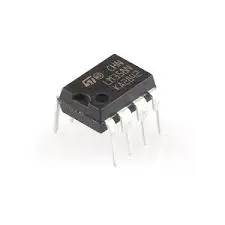Operational Amplifier Op Amp DIP LM358
The LM-358 OP Amp consists of two separate operational amplifiers. It includes features like large supply ranges, low supply current drain, independence from the supply voltage, wide unity-gain bandwidth, low input bias, open-loop differential voltage gain, internal frequency correction, and more. Operational amplifier (Op-amp) circuits, transducer amplifiers, DC gain blocks, and others are a few of the real-world uses for the LM-358.
Package Includes:
1 x Operational Amplifier Op Amp DIP LM358
Features:
Integrated with two operational amplifiers in a single package
The output voltage swing is high
The differential input voltage range is similar to the power supply voltage
Short circuit-protected outputs
Internally frequency compensated for unity gain
Input common-mode voltage range includes ground
Description:
The LM-358 consists of two high-gain frequency-adjusted operational amplifiers. They are designed to operate from a single supply or split sources over a wide voltage range. The LM-358 includes a range of notable features such as wide supply ranges, low supply current drain, supply voltage independence, wide unity gain bandwidth, ground common mode input voltage range, low input bias, open-loop differential voltage gain, and internal frequency correction. The LM-358 has several practical applications, including operational amplifier (Op-amp) circuits, transducer amplifiers, DC gain blocks, and more.
Principle of Work:
Op-amps are multistage amplifiers with intricate connections between their various amplifier stages, comprising many transistors, FETs, and resistors. These components occupy little space, making it available in the form of an Integrated Circuit (IC) packaged in a compact box. An operational amplifier can be set up to perform various operations, such as amplification, subtraction, differentiation, addition, and integration. The op-amp has two input terminals and one output terminal, along with two voltage supply terminals. The differential input consists of two input terminals: the inverting terminal (-) and the non-inverting terminal (+). If an input signal is supplied to the inverting terminal (-), the amplified output will be 180 degrees out of phase with the input signal. Conversely, applying an input signal to the non-inverting terminal (+) will result in an output signal in phase with the input.
Pin 8 is the power supply input for the LM358. The input voltage range for the LM358 comparator is 3 to 32 volts. The supply voltage range for the LM358 when used as an operational amplifier is 1.5V to 16V. The LM358 has two operational amplifiers (A and B). The inputs for the first amplifier (A) are pins 2 and 3, with the output at pin 1. The input and output of the second amplifier (B) are at pins 5 and 7, respectively, if used.
Pinout of the Module:
| Pin No | Description |
|---|---|
| 1 & 7 | Output for First OP-AMP |
| 2 & 6 | Inverts the signals by 180 degrees (e.g., -5V input results in +5V output) |
| 3 & 5 | Does not invert the signal (e.g., +5V input results in +5V output) |
| 4 | Ground |
| 8 | Vcc |
Applications:
Audio mixers
AC inverters
VF drives
Oscilloscopes
Systems with DLP front projection
Solar inverters
Uninterruptible Power Supply (UPS)
A quadruple oscillator
Circuit:
How to make an IR Proximity sensor with LM358
Components Used:
LM358
10K ohm Resistor
220-ohm Resistor
IR transmitter LED
IR receiver LED
Colored LED
5V Battery
10K ohm variable resistor
The photodiode and infrared LED are connected in parallel and function as a transmitter and receiver, respectively. The photodiode is connected in reverse bias. When an obstruction blocks the IR LED’s emitted light, the light is reflected back and intercepted by the photodiode. The reflected rays reduce the photodiode's resistance, leading to the creation of charge carriers and an electrical signal.
Library: No library is needed for this IC to function
Code: No code is needed for this IC to function
Technical Details:
Wide range of power supplies: 3V to 32V (single supply), ±1.5V to ±16V (dual supply)
Large voltage gain: around 100 dB
Wider bandwidth: 1 MHz
Low supply current: 700µA
Operating temperature range: 0˚C to 70˚C
Soldering pin temperature: 260˚C
Comparisons:
The LM358 comes in a DIP-8 package, which is smaller than the DIP-14 package of the LM324. This is the primary difference in specifications. The LM324 can dissipate more power than the LM358 due to its larger package size. This could be the reason for the increased offset voltage drift in the LM324.
| Specification | LM358 | LM324 |
|---|---|---|
| Supply voltage | 32V | 32V |
| Power dissipation | 830mW (DIP) | 1130mW (DIP) |
| Input offset voltage | 5mV | 5mV |
| Input offset voltage drift | 20µV/C (max.) | 30µV/C (max.) |
Comparing the LM741 and LM358, the LM741 requires both positive and negative supplies, while the LM358 supports single-supply operation. The LM358 allows the input to drop to 0V with a single-ended supply of 30V, while the LM741’s input range is limited to ±13V with a ±15V supply.
| Specification | LM741 | LM358 |
|---|---|---|
| Supply voltage (max.) | ±22V | 32V (±16V) |
| Input bias current (max.) | ~200nA | 100nA |
| Input voltage range (max.) | ±13V (±15V supply) | 0V – (V+ - 1.5V) (30V supply) |
